rDNA ITS Sequence Analysis and Molecular Phylogeny of Four Fungal Strains Assigned to the Family Rus
中药乌头及其近缘种的rDNA—ITS序列分析

An l sso DNA TS s q e e fp a s o o i m a d i i l g s e is a y i fr I e u nc s o l nt fAc n t u L n t sb i p c e s n
Z HANG W u ,HA Ya — ,Z in h a N n l i HU Ja — u ( ea m n o F r s a o g , na ei l oee Wuu2 10 , h a D pr et f oe i Pt l y WannM dc lg , h 40 2 C i ) t nc ho aC l n
中药 乌 头及 其近缘 种 的 r N — S序 列分析 D AI T
张 武, 韩艳丽 , 朱建华
( 皖南 医学院法 医专业 , 安徽 芜湖 2 10 ) 4 0 2
摘 要 : 用 P R扩 增产 物 直 接 测序 的 方法 对 云 南 、 徽 的 乌 头及 其 近缘 种 植 物 的 IS区碱 基 序 列 测 定 。 表 明 核 运 C 安 T
g n rg ns n . S r NA f r1 4 p e e l e e o ti e r m id f c nt m n A h ia d Yu n n . h e d r m e e f me t ,a d 5 8 D o 6 b v ny w r ban d f a o 4 kn so o i A u L i n u n n a T e d n mg a w so tie t g 2 a a ss T e I e u n e r o d moe ua l e ri e t ia in o lns o c nt m. a b an d wi Me a n l i h y . h T s q e c s ac g o lc lrma' rf d ni c t f a t f o i S k o f o p a u Ke wo d :A o i m y r s c n t L;r A T e in ;D lc lra t e t ain u DN I r go s NA moe ua u h n i t S c o
绒白乳菇rDNA ITS序列鉴定及生物学特性研究
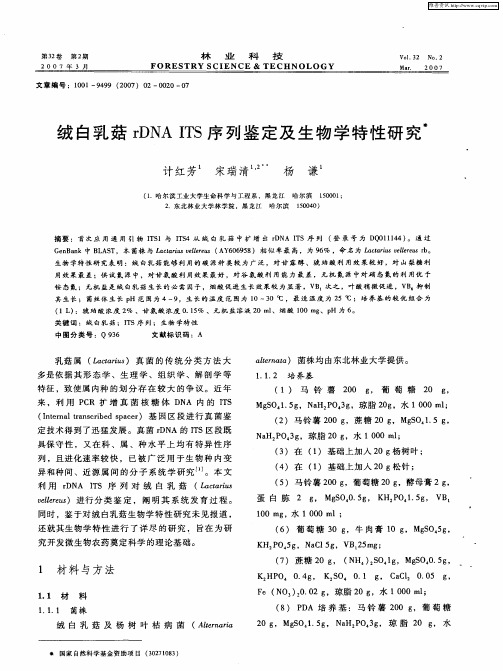
( ) 马铃 薯 2 0 g 5 0 ,葡萄糖 2 ,酵母 膏 2g 0g ,
蛋 白 胨 2 , Mg O 0 5 , K 2 O 1 5 , V 。 g S . g H P .g B 1 0m ,水 10 0ml; 0 g 0 ( ) 葡 萄 糖 3 ,牛 肉 膏 1 ,Mg O 5 , 6 0g 0g S g
1 1 1 菌株 . .
( ) P A 培 养 基 :马 铃 薯 2 0 g 8 D 0 ,葡 萄 糖
2 ,MgO 15 , N i P 4g 琼 脂 2 g 水 0g S . g a 2O 3 , l 0 ,
维普资讯
第3 卷 2
第 2期
林 业 科 技
Fo R E ST RY SC I N C E & TE C H N o L ห้องสมุดไป่ตู้ G Y E
V 1 3 NO. o. 2 2
Ma. r
20 0 7 年 3 月
2O O 7
生物 学特 性 研 究表 明 :绒 白乳 菇 能够 利 用 的碳 源 种 类较 为 广 泛 ,对 甘 露 醇 、 琥 , 酸 利 用 效 果 较 好 ,对 山 梨 糖 利 自 用效 果 最差 ;供 试 氮 源 中 , 对甘 氨 酸 利 用效 果 最好 ,对 谷 氨 酸利 用 能 力 最 差 , 无 机 氮 源 中 对 硝 态 氮 的 利 用 优 于
( 1L):琥 珀 酸 浓 度 2 、甘 氨 酸浓 度 0 1 % 、无 机 盐 溶 液 2 、烟 酸 1 0mg H 为 6。 % .5 0 ml 0 、p
关键 词 :绒 白 乳 菇 ;IS序 列 ; 生物 学特 性 T
rDNA-ITS序列分析对临床少见丝状真菌鉴定作用的评估
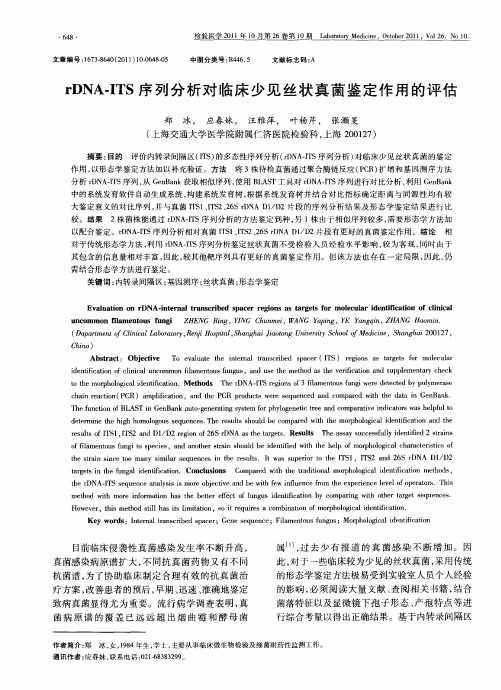
关键词 : 内转 录间隔区 ; 因测序 ; 基 丝状真菌 ; 形态学鉴定
Ev l a i n o DNA-n e n l ta s rb d s a e e i n s t r es f r mo e u a d n i c t n o l ia a u to n r i t r a r n c i e p c r r g o s a a g t o l c l r i e t a i f c i c l i f o n
T ef n t n o L T i e Ba k a t — e e ai gs s m rp yo e e i te n o a ai ei d c t r w sh l f l o h c i f AS G n n u o g n rt y t f h lg n t r ea d c mp r t i ao s a e p u u o B n n e o c v n t d t r n h ih h mo o o ss q e c s T e r s l h u d b o a e i h r h l gc lie t c t n a d te e emi e t e hg o lg u e u n e . h e ut s o l e c mp r d w t te mop o o ia d n i a i n h s h i f o
c a at n P R)a pict n n h C rdcsw r sqe cd adcm ae i h aai eB n . h i r ci ( C ne o m l a o ,adteP R pout ee eun e n o prdwt t dt nG n a k i f i h e
摘要 : 目的 评价 内转 录间隔区(T ) IS 的多态性序列分 析(D A IS序列分析 ) 临床少 见丝状真 菌的鉴定 rN — T 对 作用 , 以形态学 鉴定方 法加 以补充验证 。方法 将 3株待检 真菌通过 聚合 酶链 反应 ( C 扩 增和基 因测 序方法 P R)
核rDNA ITS区序列在无脊椎动物分子系统学研究中的应用
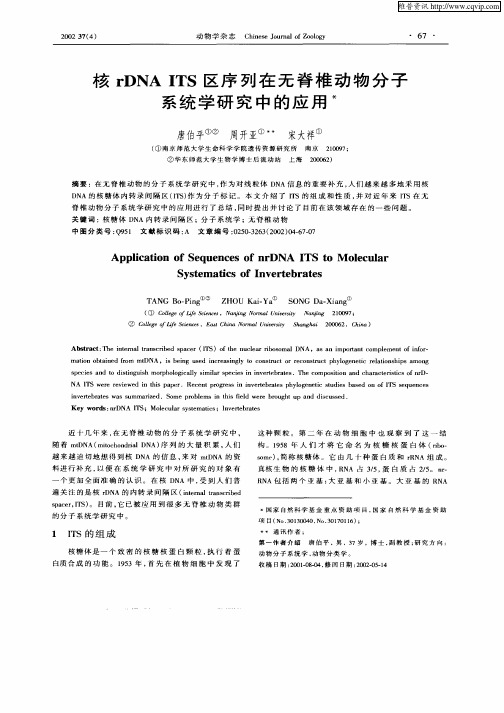
App i a i n o qu nc s o DNA TS t o e u a lc to f Se e e f nr I o M lc l r S s e atc f I e t br t s y tm i s o nv r e a e
TANG o Pi g B — n ①② Z OU iYa H Ka. ① S ONG . a g Da Xi n ①
真 核 生 物 的 核 糖 体 中 , N 占 35 蛋 白 质 占 25 n— R A /, /。 r R A包 括 两 个 亚 基 : 亚 基 和 小 亚 基 。 大 亚 基 的 R A N 大 N
一Leabharlann 这 种 颗 粒 。 第 二 年 在 动 物 细 胞 中 也 观 察 到 了 这 一 结 构 。 15 年 人 们 才 将 它 命 名 为 核 糖 核 蛋 白 体 ( b — 98 i r o sm ) 简 称 核 糖 体 。 它 由 几 十 种 蛋 白 质 和 r N 组 成 。 oe, RA
维普资讯
2 0 7 4) 0 23 (
动物 学杂 志
C ieeJ un lo o Ig hn s o r a fZ ooy
・ 67 ・
核 r DNA I S 区 序 列 在 无 脊 椎 动 物 分 子 T 系 统 学 研 究 中 的 应 用 *
近 十几年 来 , 无 脊椎 动 物 的分 子 系统 学 研 究 中, 在 随 着 mD A( ic od M D A) 列 的 大 量 积 累 , 们 tN mt h nr N 序 o i 人
越 来 越 迫 切 地 想 得 到 核 D A 的 信 息 , 对 m D A 的 资 N 来 tN 料 进 行 补 充 , 便 在 系 统 学 研 究 中 对 所 研 究 的 对 象 有 以
金针菇rDNA—ITS序列分析
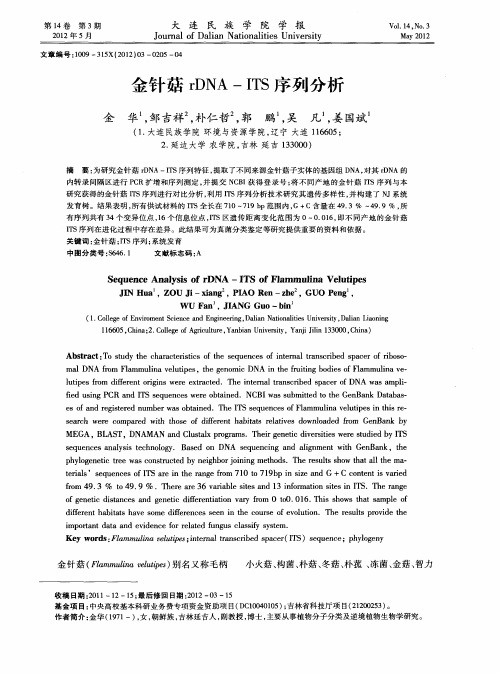
Ke r sFa mu n e t e ; tra t nc b dsae( )sq e c ; h l e y ywod : lm l avl i si en lr sr e pcr I i up n a i e u ne p yo n g
金 针 菇 ( lmm l avlte) 名 又称 毛柄 Fa ui e i s 别 n up
ma lDNA r m l mmu ia v ltp s,t e g n mi fo F a ln eu i e h e o c DNA n t r ii d e fF a i hefu t bo i so l mmu i a v — ng ln e l tp sfo d fe e to gn r x r ce u i e r m ifr n r is we e e ta t d.Th n e n lta s rb d s c ro i e i tr a r n c ie pa e fDNA s a l— wa mp i l d u i g PCR n TS s q nc swe e o ti e fe sn a d I e ue e r b an d.NCB1wa u mitd t h nBa t b s ss b te o t e Ge nk Daa a ・ e fa d r gse e u so n e itr d n mbe so t i e .Th TS s q e c so a rwa b a n d e I e u n e fFlmmu i a v l t si h sr — ln e u i n t i e pe
金 针 菇 rN D A— T 序 列 分 析 IS
金 华 邹 吉祥 2朴仁 哲 郭 鹏 吴 凡 姜 国斌 , , , , ,
(. 1 大连 民族 学院 环境 与 资源 学院 , 宁 大连 1 6 0 ; 辽 1 6 5 2 延边 大 学 农 学 院 , . 吉林 延 吉 1 3 0 ) 3 0 0
rDNA-ITS序列分析鉴定块菌伴生真菌
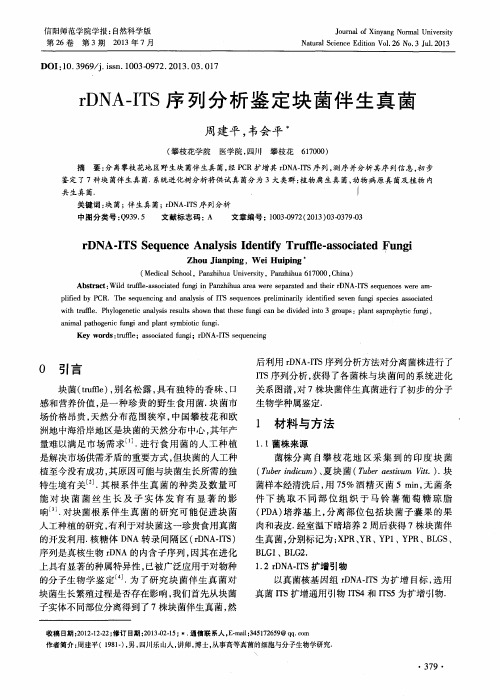
D OI : 1 0 . 3 9 6 9 / j . i s s n . 1 0 0 3 - 0 9 7 2 . 2 0 1 3 . 0 3 . 0 1 7
r D N A — I T S序 列 分 析 鉴 定 块 茵 伴 生 真 菌
周建平 , 韦会平
( 攀枝花学 院 医学 院 , 四川 攀枝花 6 1 7 0 0 0 )
0 引言
块菌 ( t r u f l f e ) , 别名 松 露 , 具 有 独 特 的香 味 、 口
后利 用 r D N A . I T S序列 分析 方法对 分 离菌株 进行 了
I T S 序列分析 , 获得 了各菌株与块菌问的系统进化
关系 图谱 , 对 7株 块 菌伴生 真菌 进行 了初 步 的分子 生物 学种 属鉴定 .
感和营养价值 , 是一种珍贵的野生食用菌. 块菌市 场价格昂贵 , 天然分布范 围狭窄 , 中国攀枝 花和欧 洲地中海沿岸地区是块菌的天然分布中心 , 其年产 量难 以满足市场需求 ¨ J . 进 行食用菌 的人工种植
1 材 料 与 方 法
1 . 1菌株 来源
是解决市场供需矛盾的重要方式 , 但块菌的人工种 植至今没有成功, 其原因可能与块菌生长所需的独 特生境有关 J . 其根 系伴生真 菌的种类及数 量可
Ab s t r a c t : Wi l d t r u f l f e ・ - a s s o c i a t e d f u n g i i n P a n z h i h u a a r e a we r e s e p a r a t e d a n d t h e i r r DN A- - I T S s e q u e n c e s w e r e a m・ -
rDNA_ITS序列分析在真菌鉴定中的应用_燕勇
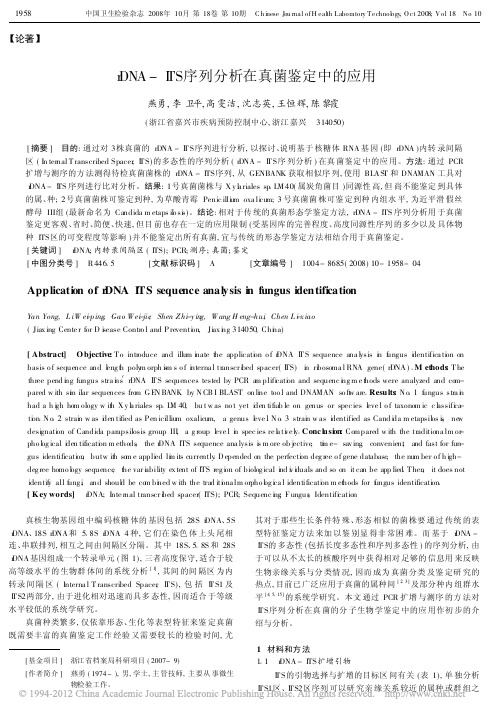
[基金项目] 浙江省档案局科研项目(2007-9)[作者简介] 燕勇(1974-),男,学士,主管技师,主要从事微生物检验工作。
=论著>r DNA -I TS 序列分析在真菌鉴定中的应用燕勇,李卫平,高雯洁,沈志英,王恒辉,陈黎霞(浙江省嘉兴市疾病预防控制中心,浙江嘉兴 314050)[摘要] 目的:通过对3株真菌的rDNA -I T S 序列进行分析,以探讨、说明基于核糖体RNA 基因(即rDNA )内转录间隔区(In ternal T ranscribed Spacer ,I T S)的多态性的序列分析(rDNA -I T S 序列分析)在真菌鉴定中的应用。
方法:通过PCR扩增与测序的方法测得待检真菌菌株的rDNA -ITS 序列,从GENBANK 获取相似序列,使用BLA S T 和DNAMAN 工具对r DNA -I TS 序列进行比对分析。
结果:1号真菌菌株与X y l a riales sp 1LM 40(属炭角菌目)同源性高,但尚不能鉴定到具体的属、种;2号真菌菌株可鉴定到种,为草酸青霉Penic illi u m oxa li cu m;3号真菌菌株可鉴定到种内组水平,为近平滑假丝酵母III 组(最新命名为Candida m etaps il o si s)。
结论:相对于传统的真菌形态学鉴定方法,rDNA -ITS 序列分析用于真菌鉴定更客观、省时、简便、快速,但目前也存在一定的应用限制(受基因库的完善程度、高度同源性序列的多少以及具体物种ITS 区的可变程度等影响)并不能鉴定出所有真菌,宜与传统的形态学鉴定方法相结合用于真菌鉴定。
[关键词] r DNA;内转录间隔区(ITS);PCR;测序;真菌;鉴定[中图分类号] R 44615 [文献标识码] A [文章编号] 1004-8685(2008)10-1958-04Application of r DNA I TS sequence analysis in fungus identificationYan Yong,L iW ei -p ing ,Gao W ei -jie ,Shen Zhi -y in g,W ang H eng-hui ,Chen L i -x iao (Jiax ing Cente r for D i sease Contro l and P reventi on ,Ji ax i ng 314050,Chi na)[Abstract] O bjective :T o introduce and illu m i nate t he applicati on o f r DNA I T S sequence ana l ysis i n f ungus i dentifica ti on on basis o f sequence and l eng t h poly m orph i s m s o f i nterna l transcr i bed spacer(I TS)i n ri bosoma l RNA gene(rDNA )1M ethods :T he three pend i ng fungus stra i ns c rDNA I T S sequences tested by PCR a m plifi cati on and sequenc i ng m e t hods were analyzed and co m-pared w ith si m ilar sequences fro m G E N BANK by N CB I BLAST on li ne too l and DNAMAN so ft w are 1Resu lts :N o 11f ungus stra i n had a h i gh hom ology w it h X y l a riales sp 1L M 40,bu t w as no t yet i den tifiab le on genus or spec ies l eve l o f taxonom ic c l assifi ca -ti on 1N o 12strai n w as i den tified as P en icilliu m oxalicu m,a genus l eve l 1N o 13strai n w as i dentified as Cand i da m etapsil os i s ,ne w desi gnati on of Candida parapsilosis group III ,a g roup l eve l i n spec ies re l a ti ve l y 1Conc l u si on :Compared w ith the traditiona lm or -pho l og ical i den tificati on m ethods ,the r DNA ITS sequence ana lysis i s m ore ob j ective ,ti m e-sav ing ,convenient ,and fast for fun -gus identificati on ,butw it h so m e appli ed li m its currently 1D epended on the perfecti on deg ree o f gene database ,the nu m ber o f h i gh-deg ree homo l ogy sequence ,t he var i ability ex tent of ITS reg i on of biolog ical i nd i v i duals and so on it can be app lied 1T hen ,it does not identif y all f ung ,i and shoul d be co m bi ned w ith the trad iti ona lm orpho l og i ca l identificati on m et hods for f ungus identificati on 1[K ey words] r DNA;Inte rnal transcr i bed spacer(ITS);PCR;Sequenc i ng ;F ungus ;Identifi cation 真核生物基因组中编码核糖体的基因包括28S r DNA 、5S r DNA 、18S rDNA 和518S r DNA 4种,它们在染色体上头尾相连、串联排列,相互之间由间隔区分隔。
rDNA-ITS序列分析在植物病原真菌分类鉴定中的应用

析 及病原腐霉的诊断和 比较各种类 的亲源关 系上 , 例如对群结腐 霉菌的鉴定 .
34 其他 分子 生物 学技 术 的应 用 聚合酶链 式反应一 链构象多 态性分析 (P R s c ) . 单 C — s P是一 种有较高 开发潜力 的技 术 ,
目前在植物病原 菌分类鉴定 中用 的还 比较 少.C — S P D A 指纹技 术 以及 D A 直接测序 法一样有简单快 速的特点, P RSC 和 N N
u i u To hm m rw的检 测 .
33 RF P 、 . L RAP 和AF P在腐霉分子研 究上的应用 限际性长度多态性 分析(R L ) 酶切 的方法对 D A 进行 序 D L F P利用 N
列多态性分 析. 在真菌 的分类 鉴定 中,R L 技术主要用 于分析相似种 间的亲源关系及种 内变异性. FP 例如采用 P R R L C — F P图
而 且更加经 济实 用 、 敏度会更 高, 是对于处 理大批量 的样 品时, C — S P比常规 P R更 有优势,只需要 一对通用 灵 尤其 P R SC C 引物就能够 同时对多个腐 霉种进行鉴 定. 对不 同的腐 霉菌株采用 r N —T 1 C — S P 析, 同的腐 霉种都有特 例如 D A IS 的P R S C 分 不 征 S C 条带,利用 这一技术可将腐霉鉴定到种. SP 线粒体 D A( D A) N mtN 用于腐霉进化 和系统研究有 一定 的优势. 例如采用不 同种属 的腐霉 菌的细胞色素 Ⅱ(CX 基 因 O Ⅱ) 序列来研 究腐霉属的 系统 发育 关系 ; 利用线粒 体细胞色素氧化酶 Ⅱ基 因及间隔 区基 因序列分析 , 把从形态特征上很难 区别 的菌株 区分 开. 目前 m D A 分 析方法在腐 霉的分子研 究上应用 还较少,将来通 过技术革 新, tN 有希望 在腐霉 D A分 析鉴定 N
贵州枇杷炭疽病病原菌的鉴定及rDNA-ITS序列分析
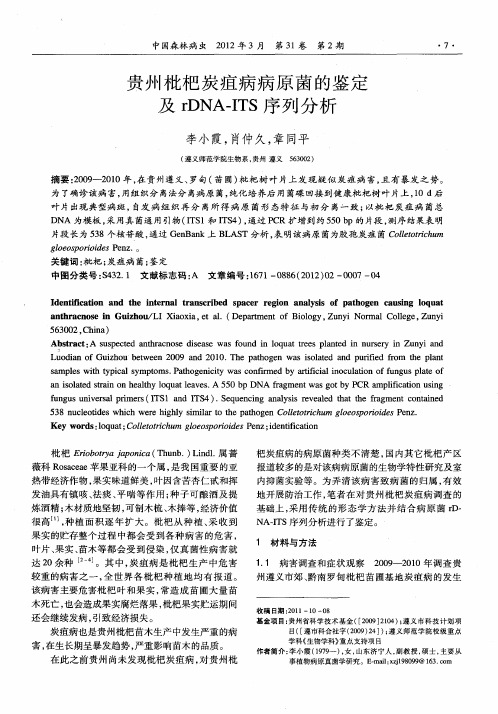
a tr c oei i o / IXi xa e a. Deat n fB oo y Z n iN r lC l g , u y nh an s n Guz u L a i, t 1 ( pr h o me to ilg , u y oma ol e Z n i e
5 3 0 C ia 6 0 2, hn )
g o o poroie e z le s i d s P n .o
关 键词 : 杷 ; 枇 炭疽 病 菌 ; 定 鉴
中图分 类 号 :4 2 1 文献 标 志码 : 文章 编 号 :6 1— 86 2 1 )2— 07— 4 ¥3. A 17 0 8 (02 0 00 0
I ntfc ton de i a i an i d t i t r l r n c i d pa e r g o a l i o pa ho e c usng o he n e na t a s rbe s c r e i n nayss f t g n a i l qua t
fn u nv r l r r( T 1 adⅡS ) S q ecn a s e eldta tef g n o t n d u g su ies i s I S n a p me 4 . eu n ig a l i rv a th r metc na e n ys e h a i
枇 杷 E ib t ajp nc (l u b ) id. 蔷 r or a o i h n . Ln 1属 o y a '
杷 炭疽病 的病原 菌种 类 不 清楚 , 内其 它 枇 杷 产 区 国 报 道较 多 的是对 该病 病原 菌 的生物 学特 性研 究及 室 内抑菌 实验 等 。为 弄 清该 病 害致 病 菌 的归 属 , 效 有 地 开展 防治 工作 , 者 在 对 贵 州枇 杷 炭 疽 病 调 查 的 笔 基础 上 , 采用 传 统 的形 态 学 方 法 并 结 合 病 原 菌 r — D N I S序列 分 析进行 了鉴定 。 A— T
rDNAITS序列分析在真菌鉴定中的应用

rDNAITS序列分析在真菌鉴定中的应用一、本文概述随着分子生物学技术的飞速发展,真菌鉴定方法也在不断革新。
其中,rDNTS序列分析作为一种高效、准确的鉴定手段,已经在真菌分类和系统发育研究中发挥了重要作用。
本文旨在探讨rDNTS序列分析在真菌鉴定中的应用,以期为该领域的研究提供有益的参考。
本文将首先介绍rDNTS序列的基本概念和特点,阐述其在真菌鉴定中的优势。
随后,将综述rDNTS序列分析在真菌鉴定中的应用现状,包括其在不同真菌类群鉴定中的应用案例、鉴定流程的优化以及数据分析方法的发展。
本文还将讨论rDNTS序列分析在真菌鉴定中存在的挑战与前景,如序列多态性、种间界限模糊等问题,并展望其未来的发展方向。
通过本文的阐述,读者可以全面了解rDNTS序列分析在真菌鉴定中的应用价值,掌握其基本原理和方法,为该领域的研究提供有益的参考和指导。
二、rDNAITS序列的基本结构和特点rDNA ITS序列,即核糖体DNA内部转录间隔区序列,是真核生物核糖体DNA中的一个重要区域。
该区域位于18S、8S和28S rDNA之间,由ITS8S rDNA和ITS2三部分组成。
其中,ITS1和ITS2是非编码区,序列长度在不同物种间存在显著差异,具有较高的可变性和种属特异性。
8S rDNA则是一段保守性较高的编码区,常用于序列的比对和定位。
高度多态性:ITS序列在种间和种内均表现出高度的多态性,这使得其成为真菌鉴定中非常重要的分子标记。
易于扩增:由于ITS序列的长度适中,且存在多个适合PCR扩增的保守区域,因此可以方便地从真菌基因组中扩增得到。
种属特异性:ITS序列的种属特异性使其在真菌鉴定中具有很高的分辨率。
通过比较不同物种的ITS序列,可以有效地鉴定到种或亚种水平。
进化速率适中:ITS序列的进化速率适中,既不过快也不过慢,这使得其既可以用于近缘物种的鉴定,也可以用于较远缘物种间的系统发育分析。
因此,rDNA ITS序列分析在真菌鉴定中具有重要的应用价值。
云南羊肚菌rDNA的ITS序列与亲缘关系分析
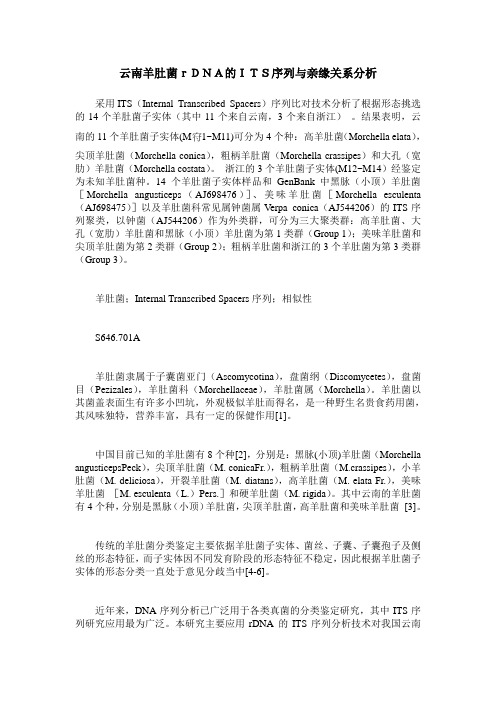
云南羊肚菌rDNA的ITS序列与亲缘关系分析采用ITS(Internal Transcribed Spacers)序列比对技术分析了根据形态挑选的14个羊肚菌子实体(其中11个来自云南,3个来自浙江)。
结果表明,云南的11个羊肚菌子实体(M 1~M11)可分为4个种:高羊肚菌(Morchella elata),尖顶羊肚菌(Morchella conica),粗柄羊肚菌(Morchella crassipes)和大孔(宽肋)羊肚菌(Morchella costata)。
浙江的3个羊肚菌子实体(M12~M14)经鉴定为未知羊肚菌种。
14个羊肚菌子实体样品和GenBank中黑脉(小顶)羊肚菌[Morchella angusticeps(AJ698476)]、美味羊肚菌[Morchella esculenta (AJ698475)]以及羊肚菌科常见属钟菌属Verpa conica(AJ544206)的ITS序列聚类,以钟菌(AJ544206)作为外类群,可分为三大聚类群:高羊肚菌、大孔(宽肋)羊肚菌和黑脉(小顶)羊肚菌为第1类群(Group 1);美味羊肚菌和尖顶羊肚菌为第2类群(Group 2);粗柄羊肚菌和浙江的3个羊肚菌为第3类群(Group 3)。
羊肚菌;Internal Transcribed Spacers序列;相似性S646.701A羊肚菌隶属于子囊菌亚门(Ascomycotina),盘菌纲(Discomycetes),盘菌目(Pezizales),羊肚菌科(Morchellaceae),羊肚菌属(Morchella)。
羊肚菌以其菌盖表面生有许多小凹坑,外观极似羊肚而得名,是一种野生名贵食药用菌,其风味独特,营养丰富,具有一定的保健作用[1]。
中国目前已知的羊肚菌有8个种[2],分别是:黑脉(小顶)羊肚菌(Morchella angusticepsPeck),尖顶羊肚菌(M. conicaFr.),粗柄羊肚菌(M.crassipes),小羊肚菌(M. deliciosa),开裂羊肚菌(M. diatans),高羊肚菌(M. elata Fr.),美味羊肚菌[M. esculenta(L.)Pers.]和硬羊肚菌(M. rigida)。
狼尾草属牧草rDNA的ITS序列分析
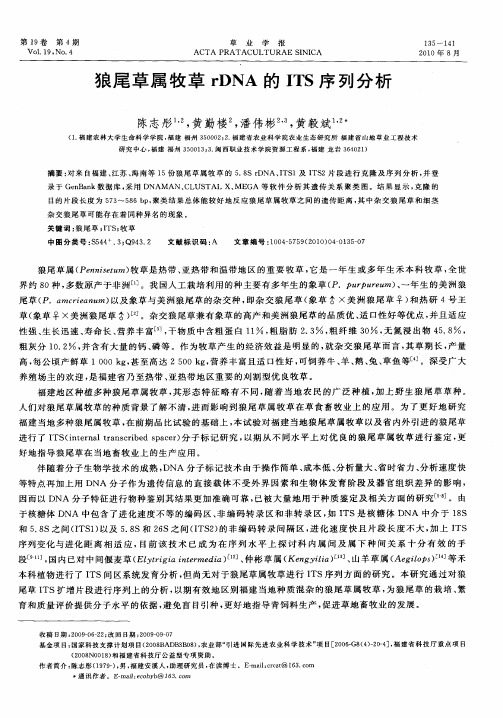
研究 中心 , 建 福 州 3 0 1 ;. 西 职 业 技 术 学 院 资 源 工 程 系 , 福 5033闽 福建 龙 岩 3 4 2 ) 6 0 1
尾草 ( .a ren m) P mcia u 以及 象 草与美 洲 狼尾 草 的杂交 种 , 杂交 狼 尾草 ( 草 含×美 洲 狼 尾草 旱 ) 热研 4号 王 即 象 和 草 ( 草 旱 ×美 洲狼尾 草 舍) 3 象 [ 。杂 交狼 尾草 兼有象 草 的高 产和 美洲 狼尾 草 的品质 优 、 口性 好等 优点 , z 适 并且 适 应
伴 随着分 子生 物学 技术 的成 熟 , DNA 分子 标记 技术 由于操作 简单 、 本低 、 析量大 、 时省力 、 析速 度快 成 分 省 分 等特 点再 加上 用 D NA 分子 作 为遗传 信 息 的直 接 载体 不 受 外 界 因素 和 生 物体 发 育 阶段 及 器 官组 织 差 异 的影 响 , 因而 以 D NA 分子 特 征进行 物 种鉴别 其 结果更 加 准确 可靠 , 已被 大 量 地用 于 种 质鉴 定及 相 关方 面 的研 究 j 唱 。由 于核 糖体 DNA 中包 含 了进 化 速度不 等 的编 码 区 、 编 码转 录 区和 非转 录 区 , I 非 如 TS是 核糖 体 DNA 中介 于 1 S 8
福建 地 区种植 多种 狼 尾草属 牧 草 , 形 态 特征 略有 不 同 , 其 随着 当地 农 民 的广 泛 种 植 , 上 野 生 狼尾 草草 种 。 响 到狼 尾草 属 牧 草在 草 食 畜牧 业上 的应用 。为 了更 好 地 研究 进
核桃种质资源rDNA—ITS序列分析
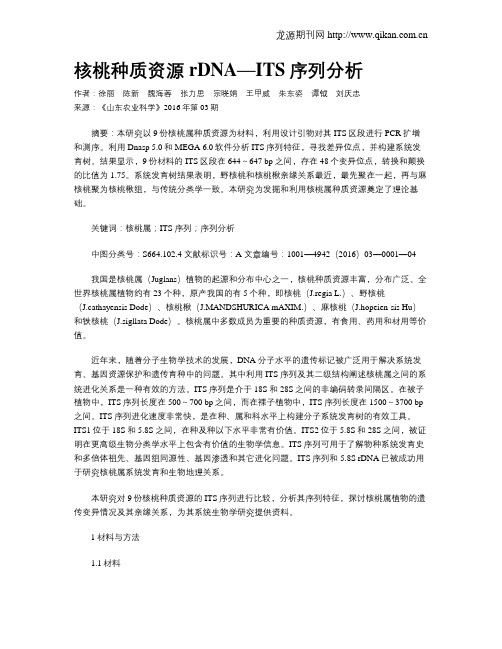
核桃种质资源rDNA—ITS序列分析作者:徐丽陈新魏海蓉张力思宗晓娟王甲威朱东姿谭钺刘庆忠来源:《山东农业科学》2016年第03期摘要:本研究以9份核桃属种质资源为材料,利用设计引物对其ITS区段进行PCR扩增和测序。
利用Dnasp 5.0和MEGA 6.0软件分析ITS序列特征,寻找差异位点,并构建系统发育树。
结果显示,9份材料的ITS区段在644~647 bp之间,存在48个变异位点,转换和颠换的比值为1.75。
系统发育树结果表明,野核桃和核桃楸亲缘关系最近,最先聚在一起,再与麻核桃聚为核桃楸组,与传统分类学一致。
本研究为发掘和利用核桃属种质资源奠定了理论基础。
关键词:核桃属;ITS序列;序列分析中图分类号:S664.102.4 文献标识号:A 文章编号:1001—4942(2016)03—0001—04我国是核桃属(Juglans)植物的起源和分布中心之一,核桃种质资源丰富,分布广泛。
全世界核桃属植物约有23个种,原产我国的有5个种,即核桃(J.regia L.)、野核桃(J.cathayensis Dode)、核桃楸(J.MANDSHURICA mAXIM.)、麻核桃(J.hopeien-sis Hu)和铁核桃(J.sigllata Dode)。
核桃属中多数成员为重要的种质资源,有食用、药用和材用等价值。
近年来,随着分子生物学技术的发展,DNA分子水平的遗传标记被广泛用于解决系统发育、基因资源保护和遗传育种中的问题。
其中利用ITS序列及其二级结构阐述核桃属之间的系统进化关系是一种有效的方法。
ITS序列是介于18S和28S之间的非编码转录间隔区。
在被子植物中,ITS序列长度在500~700 bp之间,而在裸子植物中,ITS序列长度在1500~3700 bp 之间。
ITS序列进化速度非常快,是在种、属和科水平上构建分子系统发育树的有效工具。
ITS1位于18S和5.8S之间,在种及种以下水平非常有价值。
rDNA-ITS序列分析鉴定1例念珠菌性甲真菌病病原

rDNA-ITS序列分析鉴定1例念珠菌性甲真菌病病原燕勇;朱心强;朱武通;沈志英;王恒辉;陈黎霞【期刊名称】《临床检验杂志》【年(卷),期】2009(27)5【摘要】目的探讨基于核糖体RNA基因(即rDNA)内转录间隔区(internal transcribed spacer,ITS)多态性的序列分析方法(rD-NA-ITS序列分析)在真菌鉴定中的应用.方法通过PCR扩增与测序的方法测得待检菌株的rDNA-ITS序列,从gene bank获取相似序列,使用BLAST和DNAMAN工具对rDNA-ITS序列进行比对分析,并结合形态学方法进行鉴定.结果该菌株可被准确地鉴定为Candida metapsilosis(原名为近平滑假丝酵母Ⅲ组),与Candida metapsilosis L7685株具有高度同源性(Homology98.6%,Max ident 98%).结论 rDNA-ITS序列分析用于真菌鉴定更客观、省时、简便、快速,但也存在一定的应用限制,宜与传统的形态学鉴定方法结合用于真菌鉴定.【总页数】3页(P373-375)【作者】燕勇;朱心强;朱武通;沈志英;王恒辉;陈黎霞【作者单位】浙江大学医学院营养与食品安全研究所,杭州,310058;浙江大学医学院营养与食品安全研究所,杭州,310058;嘉兴市疾病预防控制中心,浙江嘉兴,314050;嘉兴市疾病预防控制中心,浙江嘉兴,314050;嘉兴市疾病预防控制中心,浙江嘉兴,314050;嘉兴市疾病预防控制中心,浙江嘉兴,314050【正文语种】中文【中图分类】R446.5【相关文献】1.云南蓝莓枝干溃疡病病原菌鉴定及rDNA-ITS序列分析 [J], 余磊;唐旭兵;赵建荣;RARISARA Impaprasert;徐胜光;吴旭;孔垂思2.云南巴西木新炭疽病病原菌的鉴定及rDNA-ITS序列分析 [J], 吴丽芳;杨海艳;魏晓梅3.中国红麻炭疽病病原菌的分离鉴定及rDNA-ITS序列分析 [J], 刘晓倩;祁建民;陈玉森;陈绵才;陈美霞;刘伟;方平平;林荔辉;陶爱芬4.rDNA-ITS序列分析在植物病原真菌分类鉴定中的应用 [J], 李依韦;银玲5.基于rDNA-ITS和组蛋白3基因序列分析鉴定新疆棉花叶斑病病原 [J], 李映程;张国丽;任毓忠;李海强;武刚;李天义;李国英;张莉因版权原因,仅展示原文概要,查看原文内容请购买。
核糖体rDNA?ITS序列分析
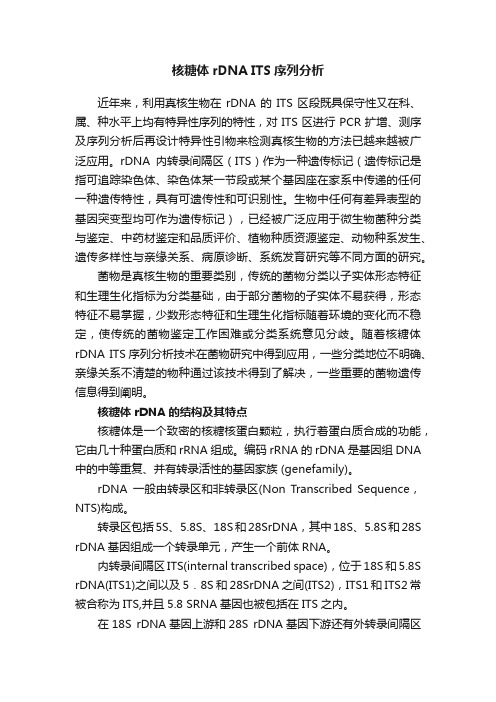
核糖体rDNA ITS序列分析近年来,利用真核生物在rDNA的ITS区段既具保守性又在科、属、种水平上均有特异性序列的特性,对ITS区进行PCR扩增、测序及序列分析后再设计特异性引物来检测真核生物的方法已越来越被广泛应用。
rDNA内转录间隔区(ITS)作为一种遗传标记(遗传标记是指可追踪染色体、染色体某一节段或某个基因座在家系中传递的任何一种遗传特性,具有可遗传性和可识别性。
生物中任何有差异表型的基因突变型均可作为遗传标记),已经被广泛应用于微生物菌种分类与鉴定、中药材鉴定和品质评价、植物种质资源鉴定、动物种系发生、遗传多样性与亲缘关系、病原诊断、系统发育研究等不同方面的研究。
菌物是真核生物的重要类别,传统的菌物分类以子实体形态特征和生理生化指标为分类基础,由于部分菌物的子实体不易获得,形态特征不易掌握,少数形态特征和生理生化指标随着环境的变化而不稳定,使传统的菌物鉴定工作困难或分类系统意见分歧。
随着核糖体rDNA ITS序列分析技术在菌物研究中得到应用,一些分类地位不明确、亲缘关系不清楚的物种通过该技术得到了解决,一些重要的菌物遗传信息得到阐明。
核糖体rDNA的结构及其特点核糖体是一个致密的核糖核蛋白颗粒,执行着蛋白质合成的功能,它由几十种蛋白质和rRNA组成。
编码rRNA的rDNA是基因组DNA 中的中等重复、并有转录活性的基因家族 (genefamily)。
rDNA一般由转录区和非转录区(Non Transcribed Sequence,NTS)构成。
转录区包括5S、5.8S、18S和28SrDNA,其中18S、5.8S和28S rDNA基因组成一个转录单元,产生一个前体RNA。
内转录间隔区ITS(internal transcribed space),位于18S和5.8S rDNA(ITS1)之间以及5.8S和28SrDNA之间(ITS2),ITS1和ITS2常被合称为ITS,并且5.8 SRNA基因也被包括在ITS之内。
rDNAITS序列鉴定深部真菌菌种的研究进展

bp之间。
rDNA-ITS序列分析的应用原理 rDNA上的18S、5.8S、28S rDNA基因序列进化
tropicalis均被正确检测出,结果与生化检测和形态 学鉴定的结果一致,且检测时间(6 h)远远小于生 化检测(26 h)和形态学鉴定(82 h)所需时间。 速率慢且相对保守,存在广泛的异种同源性,其中 小亚基18S rDNA序列常被用来研究属及属以上 分类群的演化关系,大亚基28S rDNA中的D1/D2 区域可用于属及临近等级的分类群"J。rDNA—ITS 由于不加入成熟核糖体,所以受到的选择压力较 小,进化速率较快,具有广泛的序列多态性,在其保 守性上表现为在种内不同菌株之间高度保守,而在 真菌种间差异明显,这种特点使得ITS适合于真菌 物种的分子鉴定以及属内物种间或种内差异较明 显的菌群间的系统发育关系分析【8j。ITS区域相 对较短,能够很容易根据其保守区设计通用引物, 进行PCR扩增,且该序列具有重复的多拷贝特性, 使ITS区很容易从少量、稀疏或高度降解的DNA 样品中获得一1。
由于rDNA—ITS序列能准确快速地反映出属
间、种间以及菌株间的碱基对差异,目前已越来越
万方数据
・124・
澳大利亚的96株新生隐球菌菌株的ITS区进行序
序列存在4种亚型。中国发现的原新生隐球菌上
列分析,并明确地将新生隐球菌鉴定至变种水平。
Watanabe等u副曾对12个国家的临床标本中分离 的204株申克孢子丝菌的ITSl、5.8SRNA基因和 ITS2区测序分析,发现在各株之间碱基对差异一 般是8个以内,最大差异率是3.2%,而在申克孢 子丝菌和Ceratocysis stenoceras之间碱基对的差异 率是10%以上。
存在费时及易受实验条件影响等不足,核糖体rDNA—ITS序列分析法已越来越广泛的应用于真菌属内不同种间的系统发育 研究中。本文综述了核糖体rDNA.ITS鉴定深部真菌菌种的研究进展,展望了其应用前景。
甘肃甘南野生羊肚菌 rDNA 的 ITS 序列分析
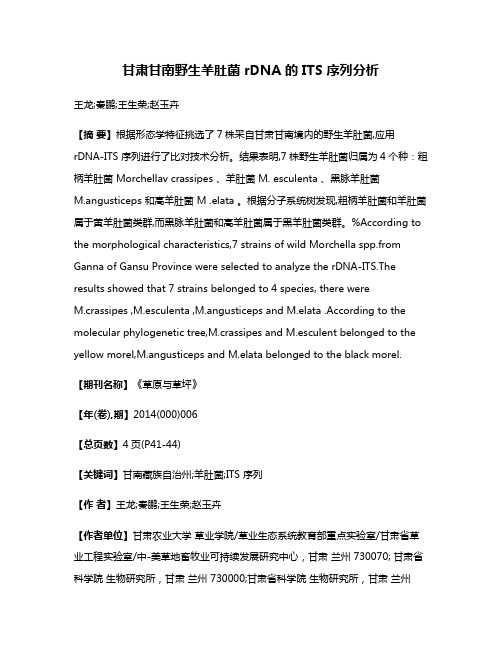
甘肃甘南野生羊肚菌 rDNA 的 ITS 序列分析王龙;秦鹏;王生荣;赵玉卉【摘要】根据形态学特征挑选了7株采自甘肃甘南境内的野生羊肚菌,应用rDNA-ITS 序列进行了比对技术分析。
结果表明,7株野生羊肚菌归属为4个种:粗柄羊肚菌 Morchellav crassipes 、羊肚菌 M. esculenta 、黑脉羊肚菌M.angusticeps 和高羊肚菌 M .elata 。
根据分子系统树发现,粗柄羊肚菌和羊肚菌属于黄羊肚菌类群,而黑脉羊肚菌和高羊肚菌属于黑羊肚菌类群。
%According to the morphological characteristics,7 strains of wild Morchella spp.from Ganna of Gansu Province were selected to analyze the rDNA-ITS.The results showed that 7 strains belonged to 4 species, there wereM.crassipes ,M.esculenta ,M.angusticeps and M.elata .According to the molecular phylogenetic tree,M.crassipes and M.esculent belonged to the yellow morel,M.angusticeps and M.elata belonged to the black morel.【期刊名称】《草原与草坪》【年(卷),期】2014(000)006【总页数】4页(P41-44)【关键词】甘南藏族自治州;羊肚菌;ITS 序列【作者】王龙;秦鹏;王生荣;赵玉卉【作者单位】甘肃农业大学草业学院/草业生态系统教育部重点实验室/甘肃省草业工程实验室/中-美草地畜牧业可持续发展研究中心,甘肃兰州 730070; 甘肃省科学院生物研究所,甘肃兰州 730000;甘肃省科学院生物研究所,甘肃兰州730000;甘肃农业大学草业学院/草业生态系统教育部重点实验室/甘肃省草业工程实验室/中-美草地畜牧业可持续发展研究中心,甘肃兰州 730070;甘肃省科学院生物研究所,甘肃兰州 730000【正文语种】中文【中图分类】S432.4羊肚菌Morchellav spp.隶属于子囊菌亚门Ascomycotina、盘菌纲Discomycetes、盘菌目Pezizales、羊肚菌科Morchellaceae,是世界公认的一类珍稀食(药)用真菌。
铁线莲属蒙药材的rDNA-ITS序列分析
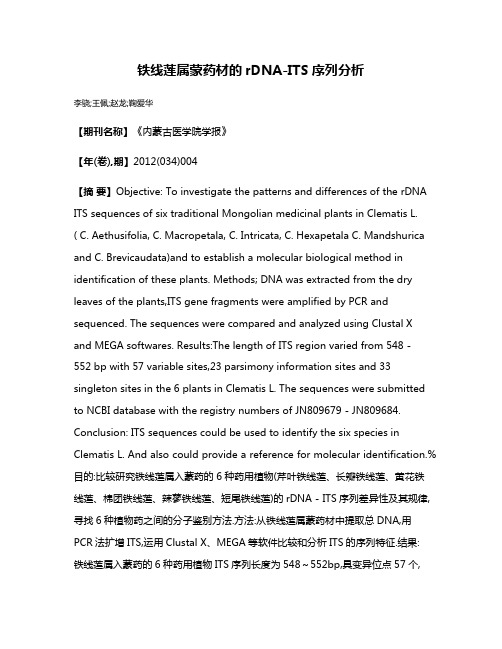
铁线莲属蒙药材的rDNA-ITS序列分析李骁;王佩;赵龙;鞠爱华【期刊名称】《内蒙古医学院学报》【年(卷),期】2012(034)004【摘要】Objective: To investigate the patterns and differences of the rDNA ITS sequences of six traditional Mongolian medicinal plants in Clematis L. ( C. Aethusifolia, C. Macropetala, C. Intricata, C. Hexapetala C. Mandshurica and C. Brevicaudata)and to establish a molecular biological method in identification of these plants. Methods; DNA was extracted from the dry leaves of the plants,ITS gene fragments were amplified by PCR and sequenced. The sequences were compared and analyzed using Clustal X and MEGA softwares. Results:The length of ITS region varied from 548 -552 bp with 57 variable sites,23 parsimony information sites and 33 singleton sites in the 6 plants in Clematis L. The sequences were submitted to NCBI database with the registry numbers of JN809679 - JN809684. Conclusion: ITS sequences could be used to identify the six species in Clematis L. And also could provide a reference for molecular identification.%目的:比较研究铁线莲属入蒙药的6种药用植物(芹叶铁线莲、长瓣铁线莲、黄花铁线莲、棉团铁线莲、辣蓼铁线莲、短尾铁线莲)的rDNA - ITS序列差异性及其规律,寻找6种植物药之间的分子鉴别方法.方法:从铁线莲属蒙药材中提取总DNA,用PCR法扩增ITS,运用Clustal X、MEGA等软件比较和分析ITS的序列特征.结果:铁线莲属入蒙药的6种药用植物ITS序列长度为548~552bp,具变异位点57个,其中信息位点23个,特异性鉴别位点33个.序列已提交至NCBI数据库,登录号为JN809679 - JN809684.结论:ITS序列对铁线莲属入蒙药的6种药用植物具有较好的分辨性,为铁线莲属蒙药材分子鉴别提供了参考.【总页数】6页(P325-330)【作者】李骁;王佩;赵龙;鞠爱华【作者单位】内蒙古医学院药学院,内蒙古呼和浩特010059;内蒙古医学院药学院,内蒙古呼和浩特010059;内蒙古医学院药学院,内蒙古呼和浩特010059;内蒙古医学院药学院,内蒙古呼和浩特010059【正文语种】中文【中图分类】R29【相关文献】1.铁线莲属蒙药材中黄酮和三萜类化合物的薄层鉴别 [J], 李骁;徐晶光;侯雪;赵科;解红霞2.铁线莲属蒙药材的化学成分和药理作用研究进展 [J], 李云飞;李骁3.胡椒属药材核糖体DNA的ITS序列分析及其分子鉴定 [J], 蔡诚诚;杨志业;谢晖;潘胜利4.铁线莲属蒙药材薄层层析图谱研究 [J], 李骁;罗彩神;解红霞;武旭芳5.浙南忍冬属药材rbcL基因序列分析 [J], 李小侠;陶正明;吴志刚;林新春;范传颍因版权原因,仅展示原文概要,查看原文内容请购买。
药用真菌金耳的rDNA ITS序列分析与鉴别
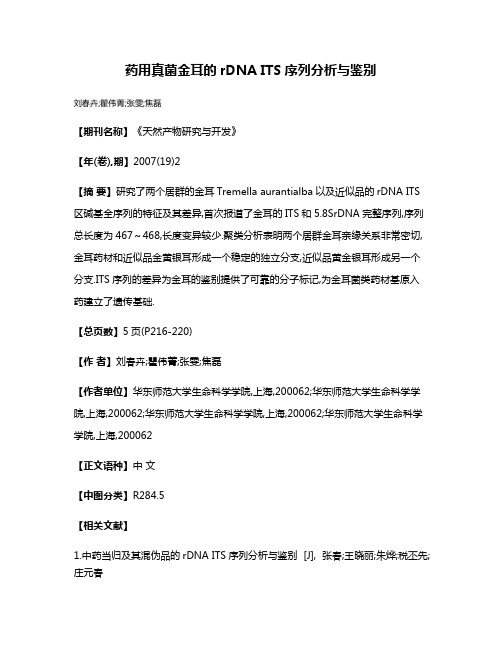
药用真菌金耳的rDNA ITS序列分析与鉴别
刘春卉;瞿伟菁;张雯;焦磊
【期刊名称】《天然产物研究与开发》
【年(卷),期】2007(19)2
【摘要】研究了两个居群的金耳Tremella aurantialba以及近似品的rDNA ITS 区碱基全序列的特征及其差异,首次报道了金耳的ITS和5.8SrDNA完整序列,序列总长度为467~468,长度变异较少.聚类分析表明两个居群金耳亲缘关系非常密切,金耳药材和近似品金黄银耳形成一个稳定的独立分支,近似品黄金银耳形成另一个分支.ITS序列的差异为金耳的鉴别提供了可靠的分子标记,为金耳菌类药材基原入药建立了遗传基础.
【总页数】5页(P216-220)
【作者】刘春卉;瞿伟菁;张雯;焦磊
【作者单位】华东师范大学生命科学学院,上海,200062;华东师范大学生命科学学院,上海,200062;华东师范大学生命科学学院,上海,200062;华东师范大学生命科学学院,上海,200062
【正文语种】中文
【中图分类】R284.5
【相关文献】
1.中药当归及其混伪品的rDNA ITS序列分析与鉴别 [J], 张春;王晓丽;朱烨;税丕先;庄元春
2.铁皮石斛及其混伪品的rDNA ITS序列分析与鉴别 [J], 张蕾;邱道寿;蔡时可;邓瑞云;罗焕明;刘晓津
3.金耳与其近似种的rDNA-ITS序列分析 [J], 刘春卉;瞿伟菁;张雯
4.头似辐首线虫的形态观察及rDNA-ITS序列分析 [J], 胡丽莉;孙彦;张悦;卜艳珍
5.少毛钝绥螨的生物学特性及rDNA ITS序列分析 [J], 黄建华; 孙强; 杨迎青; 兰波; 李湘民
因版权原因,仅展示原文概要,查看原文内容请购买。
- 1、下载文档前请自行甄别文档内容的完整性,平台不提供额外的编辑、内容补充、找答案等附加服务。
- 2、"仅部分预览"的文档,不可在线预览部分如存在完整性等问题,可反馈申请退款(可完整预览的文档不适用该条件!)。
- 3、如文档侵犯您的权益,请联系客服反馈,我们会尽快为您处理(人工客服工作时间:9:00-18:30)。
rDNA ITS Sequence Analysis and Molecular Phylogeny of Four Fungal Strains Assigned to the Family Rus1 Biotechnology Institute, Zhejiang Academy of Forestry Science, Hangzhou, Zhejiang?A310023,China;2Lishui Edible Fungi Research and Development Center,Zhejiang Essence Fungi DevelopmentCompany Ltd,Lishui,Zhejiang?A323000,ChinaInternal transcribed spacer (ITS) sequences of four edible and medicinal fungi belonging to the Russulaceae, collected from the Lishui mountainous area of Zhejiang Province, were cloned and sequenced. Comparisons with sequence data in GenBank were undertaken using BLAST, and the four ITS sequences, together with 15 reference sequences obtained from GenBank, were used to construct a phylogenetic tree. rDNA ITS sequences of the four strains ranged from 673 to 766 bp in length and between 47.4% and 49.48% in GC content. Phylogenetic data indicated strain R57 to beRussula cyanoxantha. Differences in the size and GC content of ITS sequences from strains R32 and R57 (R. cyanoxantha) and strain L37 (Lactarius sanguifluus) were significant, whereas thecorresponding differences between strains R32 and R57were relatively small. A close kinship, with only small detectable differences in their respective ITS sequences, existed betweenR. mustelina, R. virescensandR. parazurea. A similar situation applied to strains ofL. sanguifluusandL. salmonicolor.Russulaceae;?ArDNA;?AInternal Transcribed Spacer;?ASequence analysis;?APhylogeny;?AMacrofungiThe family Russulaceae is assigned to the Basidiomycotina, Hymenomycetes and Agaricales, and includes twogenera,RussulaandLactarius. According to WANG and SHI[1] and JIet al[2], 300 species ofRussulaand 400 species ofLactariushave been identified worldwide. Abundant macrofungal resources exist in the Lishui mountainous area located in southwest Zhejiang Province. According to YANGet al[3], 911 different kinds of wild fungi can be found in the Qingyuan County region of Lishui, 43 of which belong to the family Russulaceae. Most fungi assigned to the Russulaceae are edible and possess medicinal functions[4-8]. In order to produce fruiting bodies, it is essential for these fungi to form a symbiotic relationship with host plant roots and, since they have not yet been cultivated artificially, the supply of fruit bodies is limited.Although the Russulaceae has been widely studied with respect to available resources, environmental ecology, tissue isolation, nutritional and functional components, artificial cultivation and substrate fermentation[9-12], relatively little research has been undertaken on the molecular phylogeny and the extent of genetic polymorphism within the family. In this report, ITS sequences of four edible/medicinal fungi belonging to the Russulaceae and recurrently found in Lishui mountainous area, were cloned and sequenced. BLAST searches were conducted to identify homologous sequences in the GenBank database in order to provide a basis for future research on phylogenetic relationships and genetic polymorphism.1 Materials and Methods1.1Fungal strainsStrain no., and the site where fruit body samples were collected, are shown in Table 1 in the Chinese version. Strains R29, R32 and L37 have been identified to species level and designatedR. mustelinaFr.,R. cyano-xanthaSchaeff. : Fr. andL. sanguifluus(Paul.) Fr., respectively. Strain R57 has still to be identified. After collection, fruit bodies were cleaned of residualsediment, transported to the laboratory in liquid nitrogen, and thereafter preserved at-20 ℃.FU Lizhong,?ALI Haibo,?AWEI Hailong,?Aet al1.2Methods1.2.1Extraction of genomic DNAGenomic DNA was extracted from pilei (including gills) by the SDS-CTAB method[13] and purified using DNA purification kits (Hangzhou Bioer Technology Co. Ltd.). Purity was evaluated by 1.5% (w/v) agarose gel electrophoresis, and DNA concentrations were determined with a DNA/RNA UV spectrophotometer (GE Healthcare, Amer-sham, England).1.2.2rDNA ITS analysisITS-PCR amplification was performed in a programmable TC-XP thermocycler (Hangzhou Bioer Technology Co. Ltd.) in 25 μL reaction mixtures containing: 2.5 μL 10×PCR Buffer, 2 μL dNTPs (10 mmol/L), 2 μL MgCl??2 (25 mmol/L), 0.3 μLTaqDN A polyme-rase (5U/μL), 1 μL ITS5/ITS4primers[14] (10 μmol/L), 3 μL template DNA (17 ng/μL) and 14.2 μL ddH2O to volume. Amplification conditions were as follows: 1 cycle at 94 ℃for 1 min;30 cycles at 92 ℃for 15 s,61 ℃for 15 s and 72 ℃for 1 min;then a final extension at 72 ℃for 5 min.1.2.3Recovery, cloning and sequencing of ITS fragmentsITS fragments in 1.5% agarose gels were recovered using a DNA Gel Recovery Kit (Hangzhou Bioer Technology Co. Ltd), and nucleic acid concentrations were determined with aDNA/RNA ultraviolet spectro-photometer. The recovered fragments were ligated into pMD-18T Vector and transformed into competentE. coli(DH5α) cells. After blue-white spot screening and identification using PCR amplification, three random positive clones in each sample were sequenced (TaKaRa Biotechnology Co. Ltd., Dalian).1.3Comparison of ITS sequences and analysis of phylogenyAfter rem oval of the carrier sequences from the 5’and3’ends, ITS sequences were transformed into FASTA format and multiple alignments between four ITS sequences and reference sequences obtained from a BLAST search of the GenBank database were confirmed using Clustal X(Version 1.81)[15]software.A phylogenetic tree was constructed with MEGA(Version2.1)software[16]. Genetic distances were calculated using the Kimura 2-parameter model. Evolutionary distances were determined using the neighbor-joining method, and thestatistical significance of each branch of the phylogenetic tree was confirmed using bootstrap values from 1000 replicates.2 Results2.1Analysis of rDNA ITS sequencesThe amplified rDNA ITS regions of strains R29, R32, L37, and R57 consisted of 701 bp, 673 bp, 766 bp and 673 bp respectively, and the corresponding GC contents were 49.22%, 47.85%, 49.48% and 47.4% (see Fig.1 in the Chinese version). The largest difference in sequence length (93 bp) was between strain L37 and strains R32 and R57, while the largest difference in GC content (2.08%) was between strains L37 and R57. Our data indicated that significant differences existed among different genera included in the family Russulaceae. It is noteworthy that the size of the ITS sequence in strains R32 and R57 was identical (673 bp), and that the GC content differed by only 0.45%.2.2Homologous BLAST retrieval of ITS sequencesFifteen reference strains with ITS sequences similar to those of the test strains were identified by a BLAST search of the GenBank database (see Table 2 in the Chinese version). Fourreference strains, two identified asR. virescensand theother two asR. parazureaandR. mustelina, exhibited relatively high similarity with strain R29. Six reference strains, four identified asR. cyanoxantha, one as aRussulasp. and the sixth an uncultured fungus, showed relatively high similarity to strains R32 and R57. Five reference strains, four identified asL. salmonicolorand one asL. sanguifluus, exhibited relatively high similarity to strain L37.2.3Phylogenetic analysisThe four ITS sequences, together with 15 reference sequences obtained from the GenBank database were used to construct a phylogenetic tree (see Fig.2 in the Chinese version). Thirteen strains ofRussulaand six strains ofLactariusrespectively were clustered in the two genera. Strain L37 was located in the same branch as AF249289 (L. sanguifluus), and these two strains were then clustered in a group withL. salmonicolorstrains AF140258, AF140259, AF140265 and AF249287 at the bootstrap value of 100%. This suggests a relatively small sequence difference and a closer kinship betweenL. sanguifluusandL. salmonicolor.Strains R32 and R57 were located in the same branch at a bootstrap value of 100%, and these two strains formed anothercluster withR. cyanoxanthastrains AF418608, AM087258,AY606960 and AY061669, and an uncultured fungus DQ054553, at a bootstrap value of 82%. Therefore, based on these data and those shown in Fig.1, R57 and R32 should be regarded as geographically different strains ofR. cyanoxantha. Strain R29 was located in the same branch as strain AY061693 (R. mustelina) at a bootstrap value of 97%, and these two strains were clustered in a group together withR. virescensstrainsAM087264 and AY061727, and strain AY061704 (R. parazurea) at a bootstrap value of 93%. This indicated small sequence differences and close kinship betweenR. mustelina,R. virescensandR. parazurea.3 AnalysisMost fungi belonging toRussulaandLactariusare ectomycorrhizae, and have not yet been grown in artificial culture. However, pure mycelial cultures of these macrofungi can be identified using ITS sequence analysis. ITS sequence analysis has been used to identify mycelia fromR. vinos[17],L. deliciosus[18],Amanita exitialis[19] andSuillus bovinus[20].Our data indicate that ITS sequences can be used not only for themolecular identification ofRussulaandLactarius, fungi that are not easy to accurately identify to species level using morphological characteristics, but also for preliminary estimates of phylogeny and kinship between different species of Russulaceae.Strain R57 was identified in this study asR. cyanoxanthabased on ITS sequence similarities and the close clustering of their respective ITS sequences in the phylogenetic tree. There are no standard definitions of species based on ITS sequences[21,22], although ITS sequences are good molecular indicators for comparative interspecies and intraspecies research. We consider ITS sequence analysis combined with fruit body morphological characterization to be more scientifically credible for identifying and classifying macrofungi, especially when those fungi cannot be easily and accurately identified based on fruit body morphology alone.WANG QY, SHI MB. Present and future ofRussulain China [J]. Edible fungus of China, 2004,23(4):10-12. (in Chinese with English abstract)[2]JI HF, YANG Q, SONG RQ. Progress in the application ofRussula[J]. Forestry Sciences & Technology,2006, 31(3): 28-30. (in Chinese)[3]YAO PS, YAO QS, YAO CR. A survey of wild fungi resources in Zhejiang Province Qingyuan County[J]. Edible Fungi of China,2002,21(4):27-29. (in Chinese)[4]LI HZ, HUANG DX, XU XP. Advances in the biochemical characteristics ofRussula[J]. Edible Fungi of China, 1999, 18(4): 8-10. (in Chinese)[5]GAO JM, DONG ZJ, LIU JK. A new ceramide from the basidiomyceteRussula cyanoxantha[J]. Lipids, 2001, 36(2): 175-180.[6]GAO JM, DONG ZJ, LIU JK. The constituents of the basidiomyceteRussula cyanoxantha[J]. Acta Botanica Yunnanic, 2000, 22(1): 85-89. (in Chinese with English abstract) [7]YU P, LIU YR, LIN X. Study on the physicochemical properties and antitumor activities of polysaccharides from fruit bodies ofRussula[J]. Natural Product Research and Development, 2006, 18(B06): 30-34. (in Chinese)[8]CAI XL, HU CY, LIU MP,et al. Effect of fruit bodies and polysaccharide ofRussulaon mice hemorrhagic anemia [J]. Edible Fungi, 2002, 24(1): 40-41. (in Chinese)[9]XU XP, LI HZ, HUANG DX. Study on ecology ofRussula[J]. Edible Fungi of China, 2001, 20(2): 25-27. (inChinese with English abstract)[10]TU YH, CHEN YC, ZHENG ZK. Features that determine the presence ofRussula vinosaLindbl Fr. in a forest community located in Dingban Village of Datian County[J]. Journal of Plant Resources and Environment, 2001, 10(2): 26-30. (in Chinese with English abstract)[11]FAN L. Geographical distribution ofRussulain Fujian Province and the type of vegetation determining fungal growth [J]. Edible Fungi, 2006, 28(4): 4-6. (in Chinese) [12]CHEN XJ, GAN YK, WANG MG,et al. Isolated and purified cultures ofRussula[J]. Journal of Yulin Teachers College, 2005, 26(5): 64-65, 77. (in Chinese)[13]ZENG DX. Extracting DNA from edible fungi for RAPD analysis[J]. Biotechnology, 2003, 13(2): 20-21. (in Chinese)[14]WHITE TJ, BRUNS TD, LEE S,et al. Amplification and direct sequencing of fungal ribosomal RNA genes for phylogenetics. In Innis MA, Gelfand H, Sninsky JS, White TJ (eds.) PCR protocols: A Guide to Methods and Applications[M]. New York: Academic Press, 1990: 315-322.[15]THOMPSON JD, GIBSON TJ, PLEWNIAK F,et al. The Clustal X windows interface: flexible strategies for multiplesequence alignment aided by quality analysis tools[J]. Nucl Acids Res, 1997, 25(24): 4876-4882.[16]KUMAR S, TAMURA K, JAKOBSEN IB,et al. MEGA2: Molecular evolutionary genetics analysis software[J]. Bioinformatics, 2001, 17: 1244-1245.[17]WANG GW, SUN WB.Nucleotide sequence analysis on rDNA ITS of fruit bodies and isolates ofRussulain Guangxi [J]. Guangxi Sciences, 2004, 11(3): 261-265. (in Chinese with English abstract)[18]XIONG T, XIAO M, ZENG ZL,et al.Molecular identification ofLactarius deliciosusisolate by ITS Analysis [J].Microbiology,2006,33(4):1-4. (in Chinese with English abstract)[19]ZHANG P, CHEN ZH, HU JS,et al. Production and characterization of amanitin toxins from a pure culture ofAmanita exitialis[J]. FEMS Microbiol Lett, 2005, 252(2): 223-228.[20]TONG LH, LIAN B. A simplified method for extracting DNA from the mycelium of edible fungi [J]. Food Science, 2005, 26(8): 318-320. (in Chinese with English abstract)[21]LANDEWEERT R, LEEFLANG P, KUYPER TW,etal. Molecular identification of ectomy-corrhizal mycelium in soil horizons[J]. Appl Environ Microbiol, 2003, 69(1):327-333.[22]TAYLOR JW, JACOBSEN DJ, KROKEN S,et al. Phylogenetic species recognition and species concepts in fungi [J]. Fungal Gen Biol, 2000, 31: 21-32.注:“本文中所涉及到的图表、注解、公式等内容请以PDF格式阅读原文。
